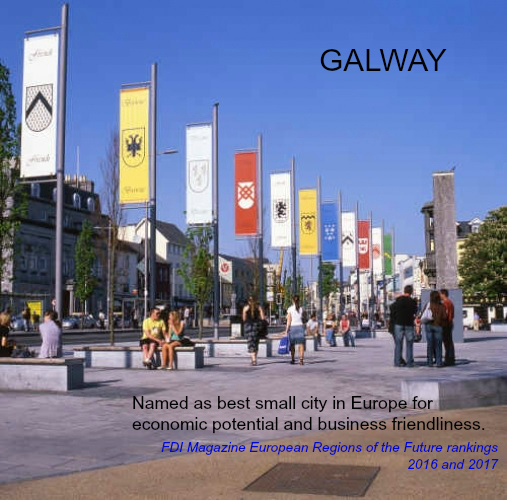Donncha Hughes's Blog: Blog of Donncha Hughes, page 6
December 22, 2017
Scratch yourself this Christmas!!!
My christmas message 2017 was inspired by the kids summer camp when they learned scratch – this is an admittedly limited attempt but I hope you take a few seconds and that it makes you smile!

This is a screenshot – click below to play
This definitely plays using Firefox if you enable Flash but not sure about Chrome or Internet Explorer. Here’s the link to the project on Scratch
Press the Green Flag to start.
You then have option to click on the Snowman with your mouse
Press the space bar!!
You might need to refresh the browser (F5) when the animation is finished to reload.
Happy Christmas from Donncha Hughes (and my creative assistants)
To all my customers, the many startup entrepreneurs who allowed me to share their journey this year, collaborators in business, and the enterprise ecosystem stakeholders that I engage with on an ongoing basis across Ireland, I wish you all a Happy Christmas and a Peaceful New Year.
Best regards
donncha(@donnchadhh)
Related PostsAbout The Startup Business Planning Jigsaw (Feb 23, 2015)
Managing a startup business is NOT easy. Startup entrepreneurs have lots of balls in the air. Lean ...
The Dip By Seth Godin : A Book Review (Feb 13, 2015)
Being the Best in the World is seriously Underrated ... Seth Godin The Dip
You might ...
Working with a Startup to Prepare a Business Plan (Jan 23, 2015)
I am delighted to publish a Case Study of and testimonial for my work. It outlines in detail how I ...
Running a ‘freelance’ business in Ireland in 2015 (Jan 12, 2015)
At the beginning of 2014, I wrote an article reviewing 2013 and setting out my business ambitions ...
Merry Christmas 2014 (Dec 18, 2014)
2014 was a great year for my business thanks to all my wonderful customers! I want to take this ...
The post Scratch yourself this Christmas!!! appeared first on Donncha Hughes, Business Trainer, Advisor & Mentor.
Thanks for signing up to my feed
regards
donncha
p.s why not also check out my other website www.startupwebtraining.com
December 10, 2017
Congrats to Galway’s next wave of Super Food and Drink Entrepreneurs
I recently attended the Galway Chamber Business Awards. Pat McDonagh, Founder of Supermacs delivered a fantastic speech in accepting the Special Presidents Award for his contribution to business in Galway. The performance of Supermacs, Ireland’s largest indigenous quick service restaurant chain, is amazing:
Over 100 outlets across country and employs over 2,700 people.
Annual commitment to Irish farmers in excess of €20 million per annum.
Huge congrats to Pat McDonagh of @SupermacsIRE for receiving the Special Presidents Award, kindly sponsored by @PwC #GCBizAwards pic.twitter.com/qBqC4bRS5n
— Galway Chamber (@GalwayChamber) November 10, 2017
The future for Supermacs seems very bright as Mr McDonagh stressed when congratulating the entire Supermacs team on their contribution to winning the award.
The Business of Clean Cut Meals – Micheal & Conor
 IBYE is a fantastic competition. Galway LEO recently announced the 2017 winners in the three Best Young Entrepreneur categories: Business Idea, Startup Business and Established Business.
IBYE is a fantastic competition. Galway LEO recently announced the 2017 winners in the three Best Young Entrepreneur categories: Business Idea, Startup Business and Established Business.
Winners and runners up tonight in the Galway #IBYE competition. High quality pitches in all 3 categories. A sincere thank you to all participants from all of us @GalEnterprise pic.twitter.com/vefKm3wC93
— LEO Galway (@GalEnterprise) December 7, 2017
I was delighted that Clean Cut Meals won the Established Business Award. Micheal Dyer participated on a graduate entrepreneurship programme that I delivered on behalf of GMIT iHubs (George McCourt and Maria Staunton) a few years ago (2015). At the time the onus was on Micheal and his business partner Conor to launch the business utilising a new business model – meals direct to the consumer copying a model that was gaining momentum in the US. The process was classic bootstrapping – they had no money, needed a kitchen and to convince customers to pay in advance. That was 2015. Since then, I kept an eye on Clean Cut Meals as they are brilliant on Social Media – see this article in This is Galway.
A few weeks ago, I was delighted that Micheal contacted me asking to meet as he was applying for IBYE. This week, we met again in SCCUL Enterprise Centre, Ballybane for an hour to review the draft 5 minute Pitch for IBYE- thanks to Michael Smyth for the room! Clean Cut Meals is a brilliant story, both ups and downs, to date and has a great future with Micheal at the helm. In the three years, they have developed:
A profitable business with 9 Employees
A brilliant brand (and website)
Hundreds of loyal customers every week – catering to a customer base equivalent to two of Galway’s busiest hotels.
A nationwide service; and
A plan for 2018 to include a move to a bigger facility based on growth in Ireland and launching into the UK.
So yes I am talking about Clean Cut Meals in the same blogpost as Supermacs. No pressure Micheal!
Congrats also to Padraic O’Griallais of Micil Poitin on their award – I met Padraic for a chat a few months ago and was hugely impressed with his drive, ambition and smart approach to business.
So the future of Food & Drink in Galway is in safe hands. Special mention also to Clare ofThe Galway Food Company in this regard – another business with international potential.
Thrilled with our Silver Award! @BOIstartups @StartupsIreland #boistartupawards pic.twitter.com/ibcwioS8V1
— The Galway Food Co (@thegalwayfoodco) May 18, 2017
I am sure that there are more Galway Food and Drink Entrepreneurs worthy of inclusion here – please feel free to comment and include links. Best of luck to all Galway representatives in the IBYE regionals.
Best regards
Donncha (@donnchadhh)
p.s shares on Social Media appreciated.
Future of Food & Drink in Galway is bright – my latest blog .. https://t.co/qgEqxNdHBV #ibye #Galway #Startup pic.twitter.com/RMqm8FaPer
— Donncha Hughes (@donnchadhh) December 10, 2017
Related PostsThe Dip By Seth Godin : A Book Review (Feb 13, 2015)
Being the Best in the World is seriously Underrated ... Seth Godin The Dip
You might ...
Working with a Startup to Prepare a Business Plan (Jan 23, 2015)
I am delighted to publish a Case Study of and testimonial for my work. It outlines in detail how I ...
Running a ‘freelance’ business in Ireland in 2015 (Jan 12, 2015)
At the beginning of 2014, I wrote an article reviewing 2013 and setting out my business ambitions ...
Merry Christmas 2014 (Dec 18, 2014)
2014 was a great year for my business thanks to all my wonderful customers! I want to take this ...
Crafting your Value Proposition : EI New Frontiers Blogpost (Oct 19, 2014)
I was delighted to be selected as one of the first contributors to new Enterprise Ireland New ...
The post Congrats to Galway’s next wave of Super Food and Drink Entrepreneurs appeared first on Donncha Hughes, Business Trainer, Advisor & Mentor.
Thanks for signing up to my feed
regards
donncha
p.s why not also check out my other website www.startupwebtraining.com
July 21, 2017
What ‘grants’ and other supports apply to my startup business?
If you have ever wondered what supports that you and your startup business could and should apply for, read on:
This blogpost was first written in 2011, and has been updated several times most recently in July 2017. The accompanying presentation has also been updated.
This original blogpost is still largely accurate. The big 4 changes: include the Enterprise Boards being rebranded as the Local Enterprise Offices while Enterprise Ireland have also rebranded the EPPs as New Frontiers. The scheme formerly known as Seed Capital Relief is now SURE – Startup Refunds For Entrepreneurs. Finally, CSF has also been launched since this post was first published!
BTW, in 2013, I wrote a related blogpost for Small Business Can that lists 5 starting points for help from the Enterprise Agencies when you are starting a business – including an old version of the image below:
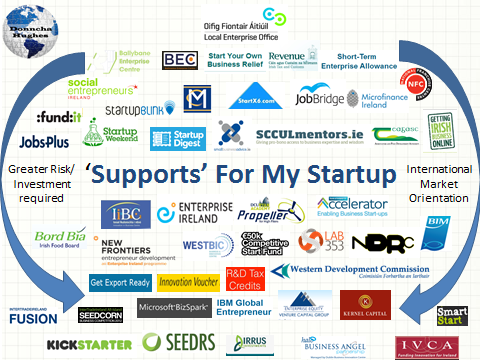
This article will now address the supports available depending on the stage of development of your startup company: pre-enterprise; early stage; and established startup.
Pre-Startup Trading
For those in the pre-enterprise stage (thinking of starting up and probably working) the options are:
• Feasibility
• Start Your Own Business Programmes, and
• Mentoring.
In Ireland the bodies who are worth talking to at this stage include the Local Enterprise Office; Enterprise Ireland; the BICs such as WestBIC; Partnerships and possibly the Chambers.
Your local bank manager is also worth approaching! The website Smallbusinesscan.ie is definitely worth a visit. Best LinkedIn group is Startup Ireland to compliment their website and offline networking while I also recommend the Startup Digest for an up to date digest of events for Startups in Galway, Limerick, Dublin and/or Cork.
And don’t forget to talk to your local Social Welfare Office about the Back to Work Short Term Enterprise Allowance. Other organisations to contact include Social Entrepreneurs Ireland and your local Community Enterprise Centres.
Early Stage Startups
For companies in the early stage of business the enterprise support agencies become more relevant:
• Innovation Vouchers
• BOI StartLab
• Priming Grant with your LEO
• Get Export Ready programme incorporating the FirstFlight Programme.
Campus incubation centres such as ArcLabs (Waterford), Synergy Centre (Tallaght) and the Innovation Hubs (iHubs) in GMIT are a great resource to startup entrepreneurs. New Frontiers is Ireland’s national entrepreneur programme located in the Institutes of Technology around the country.
The Competitive Start Fund is also relevant at this stage – check out my blogposts on applying for CSF. NDRC @ Portershed is a new programme commencing in Galway in July 2017.
The Microsoft BizSpark Programme is also worth investigating.
Established Startup Supports
For more established startup businesses the Local Enterprise Offices offer Business Expansion Grants while for companies with international potential Enterprise Ireland offer:
• Strategic Consultancy,
• R&D supports and
• HPSU supports to include equity investment, key person support
• Access to international offices
• Use of their information centre.
• Horizon 2020 funding to include SME Instrument
InterTrade Ireland also offer a range of supports to startups and SMEs to include Fusion and Acumen and of course the Seedcorn Competition (see my business plan case study about a client company which won a Regional award of €20,000 in 2014)
Other finance supports to be aware of are MicroFinance Ireland (previously First Step); Startup Refunds for Entrepreneurs (SURE) formerly known as Seed Capital Relief; and Employment and Investment Initiative (EII)] previously called as Business Expansion Scheme (BES).
Other organisations to check out include: Enterprise Equity (AIB Seed Capital Fund); Kernel Capital (Bank of Ireland Seed Capital Fund); and HBAN – the business angel network to include WXNW (West by North West) which was established in April 2015; Nucleus Venture Partners; Seedups.com; Fundit.ie; IBM Global Entrepreneur Initiative and the Small Business Advice Programme; Skillnets, Plato, and Supply Network Shannon.
BTW, Intertrade Ireland offer monthly regional clinics with Drew O’Sullivan aimed at helping companies seeking equity investment – this would be a good starting point for companies seeking equity investment. My blogpost on crowdfunding might also be of interest.
All of the organisations listed in this blog have specific criteria that you should familiarise yourself with before making an official application. I think it is worth contacting them for a chat at an early stage to build a relationship.
As always I welcome your comments and suggestions. I would appreciate your help in adding to this list!
Related PostsTwo hour Negotiations Workshop, DCU Invent, 10th November (Nov 5, 2015)
Donncha provides two hour, half day and full day Negotiations Workshops. Please contact to discuss ...
Ten things we probably knew and were reminded of during Startup Gathering Galway 2015 (Oct 14, 2015)
9th October Galway
Last Friday (9th October 2015) was spent meeting new business acquaintances ...
[Book Review] My favourite Startup Marketing Books for Fast Growth Businesses (Jul 22, 2015)
In December 2013, I wrote a blogpost selecting my four favourite Lean Startup books ...
[Book Review] Disciplined Entrepreneurship : 24 Steps to a Successful Startup by Bill Aulet (2013) (Jul 13, 2015)
I have just finished reading Disciplined Entrepreneurship by Bill Aulet, Managing Director, ...
About Startup Galway Pitches Meetup (Apr 19, 2015)
In March 2015, I volunteered to become a joint Co-ordinator along with Conor O'Donovan of the ...
The post What ‘grants’ and other supports apply to my startup business? appeared first on Donncha Hughes, Business Trainer, Advisor & Mentor.
Thanks for signing up to my feed
regards
donncha
p.s why not also check out my other website www.startupwebtraining.com
June 15, 2017
4 Point Formula to Win funding – The Startup Pitch [Book review]
I assist startups via training and mentoring to pitch for early stage investment to include enterprise agency supports such as New Frontiers and Competitive Start Fund in Ireland. I was delighted to find a superb book by Chris Lipp called ‘The Startup Pitch : A proven formula to win funding’. At 160 pages, it is a very readable book that matches up to its promise as “the single most complete reference source for pitch skills used in today’s startup world”. The book’s UVP is spelt out on the back cover:

From the Back Cover of The Startup Pitch by Chris Lipp
This blogpost will now pick out some salient points from ‘The Startup Pitch: A Proven Formula to win Funding’ which I bought from Amazon.co.uk for £20.
Layout of The Startup Pitch
The four point pitch formula is outlined in Chapter 2 of six chapters as illustrated in graphic below adapted from the Contents section of The Startup Pitch.

6 chapters – Chapter 2 is the 4 Point Pitch Formula
The introduction stresses that there is a formula for how to pitch successfully. You don’t need to be a master presenter or persuader to win funding, it simply takes the right techniques applied consciously to capture capital.
The Four Point Pitch Formula
Raising money is the second hardest part of starting a startup – Paul Graham.
On page 21, the author Chris Lipp explains that he has identified four critical points of information that must be communicated to investors – after watching many of the best and brightest around Silicon Valley. These are Problem-Solution-Market-Business.
 One begins with the problem, or the need being addressed. Then proceed to product or service that fulfills the need. The market is the target customer to whom you will offer your solution. Finally, business is all about the ways you’re going to capture that market. The book includes effective summaries on the final page. On page 55 a breakdown of Problem-Solution-Market-Business is provided in worksheet format – this can be downloaded at speakvalue.com (on provision of an email address).
One begins with the problem, or the need being addressed. Then proceed to product or service that fulfills the need. The market is the target customer to whom you will offer your solution. Finally, business is all about the ways you’re going to capture that market. The book includes effective summaries on the final page. On page 55 a breakdown of Problem-Solution-Market-Business is provided in worksheet format – this can be downloaded at speakvalue.com (on provision of an email address).

Click to download from Speakvalue.com
Here is my summary of each subheading:
PROBLEM
Description … set high level context for the subject and then start your pitch with a simple problem description to capture investor attention. Starting with a clear problem orients your audience towards the solution by engaging their natural problem solution thought process. You introduce a ‘knowledge gap’ when you start by outlining a problem.
Pains … problem pains are the consequences to people or businesses with the problem. They may be high cost, inconvenience, or inability to achieve certain goals. The greater the consequences the more strongly people want a solution. The more people want a solution, the less appear you present as an investment opportunity.
Trends – page 27 social, economic and technology trends open up markets. Trends help to transition from problem to solution.
SOLUTION
USP … single sentence UVP of what you do and why you’re unique. Avoid verbose language preferring simplicity and clarity via brevity. Be concise.
Demo … your product through the experience of a hypothetical customer
Benefits … translate product features into explicit customer benefits
MARKET
Target – the market is the customer base you can reach today. Use customer personas.
Size – cite market research reports
Advantages – explain your competitive advantage over other solutions on the market
BUSINESS
Go to Market – business is how you bring your solution to market and make money. Introduce go-to-market strategy to explain how you get, keep and grow your customer base
Revenue Model – to show how you monetize from going to market
Milestones – List out past and future milestones to show accomplishments and where you’re heading.
The point is made that not all pitches are the same, and not all points are equally important to your pitch – so you don’t necessarily have to allocate equal time to each. But they all have to be addressed as these are the areas where investors will have questions so answers need to be prepared.
The formula presented in the book is very persuasive. But it does seem to omit one key element which is the Team. But that concern is resolved in Chapter 3:-
Four Elements of Influence (chapter 3)
To win funding you need more than a Pitch formula. You must prove what you Pitch is True
Click To Tweet
The author explains that the Four Point Pitch Formula is only the foundation. It’s not enough to simply describe the problem and share your solution, market, and business. You need to prove there’s a problem, prove your solution solves the problem, prove there’s a market, and prove the efficacy of your business model. He adds that the key ingredients of persuasion are credibility, audience value, data and story as per image below:

p.64 The Startup Pitch – The Four Elements of Influence
Unlike the 4 Point Pitch which flows in a linear progression, the Elements of Influence can be applied in any order to Problem, Solution, Market and Business. The book goes into sufficient detail in chapter 3 to explain each of the four elements as they apply to each of the Four Pitch Points. Here is my quick synopsis.
Credibility is your perceived knowledge and expertise regarding the topic of discussion. Show you are an expert or share expert opinions to add clarity to the Problem, the solution, the market and business.
Audience Value means tailoring your message to fit potential benefits to the listeners. Investors want to hear how your startup provides low risk high return. For instance, detailing the number of people suffering from a stated problem represents opportunity.
Data are the facts, the research, the statistics. What’s the evidence that your solution or business plan works? Data make the problem real – not just an entrepreneur’s opinion.
Story is the emotional component, the customer anecdotes, your own experience. Emotions motivate action. Make the problem real (with data), and then bring the problem to life.
The author concludes that adding credibility, audience value, data and story into the points of your pitch proves to investors that you’re worth the investment.
Make it Clear. Make it Interesting. Make it Real. Make it Meaningful #TheStartupPitch
Click To Tweet
So the Team factor particularly the credibility of the founding team is measured by your knowledge, experience, and clarity when pitching.
Other Areas Addressed in The Startup Pitch
The section on Pitch Delivery is very good – a key point being that all investor pitches are conversations.

The point is made (page 115) that practice isn’t just knowing what to say, it’s saying it out LOUD. There is no need to memorize the pitch – just make it your own.
Chapter 5 addresses how to design and create effective Slide decks.

The advice is to keep slides simple by showing only one message per slide. BTW, if anyone is looking for help with Pitch Slide preparation I highly recommend Ed Fidgeon-Kavanagh of Clearpreso.com – he has a superb track record of helping startups to raise funding. The portfolio of case studies is worth checking out.
Conclusion – Recommended Read
I highly recommend The Startup Pitch to startup entrepreneurs who are in the words of the author serious about raising funding. I will conclude by referring to a passage on page 119 about the goal of a pitch deck
Good meetings end with follow up meetings. There’s a process to winning investment, and the goal of your pitch is to proceed through this process.
Hope you found this blogpost of interest. Comments and shares on Social Media welcomed and appreciated.
Donncha will be delivering a ‘Competitive Start Fund Masterclass’ in the Regional Development Centre, Dundalk Institute of Technology on Monday 26th June 2017. The CSF process includes a 4 minute pitch to an investment panel to secure €50,000 investment – please contact New Frontiers Manager, Garrett Duffy for further details or book your place online.
regards
donncha (@donnchadhh)
[images sourced from Pixabay.com – a great source of royalty free images]
Related PostsAbout Startup Galway Pitches Meetup (Apr 19, 2015)
In March 2015, I volunteered to become a joint Co-ordinator along with Conor O'Donovan of the ...
Date for Diary : ‘Business Application Writing for Success’ (Mar 31, 2015)
As you may know, I am a member of the SCCUL Mentors programme. This provides pro bono mentoring for ...
About The Startup Business Planning Jigsaw (Feb 23, 2015)
Managing a startup business is NOT easy. Startup entrepreneurs have lots of balls in the air. Lean ...
The Dip By Seth Godin : A Book Review (Feb 13, 2015)
Being the Best in the World is seriously Underrated ... Seth Godin The Dip
You might ...
Running a ‘freelance’ business in Ireland in 2015 (Jan 12, 2015)
At the beginning of 2014, I wrote an article reviewing 2013 and setting out my business ambitions ...
The post 4 Point Formula to Win funding – The Startup Pitch [Book review] appeared first on Donncha Hughes, Business Trainer, Advisor & Mentor.
Thanks for signing up to my feed
regards
donncha
p.s why not also check out my other website www.startupwebtraining.com
January 8, 2017
Galway’s Startup Scene : 2017 Snapshot
In late 2016, Startupblink contacted me to write a ‘Startup Ecosystem article‘ on Galway to feature on their global website. I agreed and enlisted the assistance of John Breslin, NUIG, PorterShed and Startup Galway; and Barry Egan, Enterprise Ireland West Region.
Read Galway’s Ecosystem report
The brief was very specific with set questions to be answered such as:
Please start with a quick introduction of the city (population, most interesting facts) and then also write a freestyle paragraph of description of startup ecosystem, what do you think about it, how is it like.
This was because Startup Blink have published Startup Ecosystem Reports from around the world on every continent to include: London, Paris, Switzerland, Leipzig (listening recently to Off the Ball about their ‘interesting’ football team), Chicago, Caracas, Brisbane and Bangalore to name but a few.

Startupblink.com Connecting the Startup Ecosystem
CALL TO ACTION
Add you organisation to the Startupblink Interactive Map – registration required. The resource lists startups, co-working spaces, accelerators, leaders, investors, meetups and other organisations that support startups.
Hope you like the article. Comments and shares on social media appreciated
regards
donncha
p.s for more like this article, check out this blogpost ‘From Digital Nomad to Galway City Slicker‘ by Katleen. It is a good read and the sign off with references to the Startupblink article and others on Galway. John Breslin seems to be the common theme!
Galway Startup Ecosystem: What You Need To Know by @donnchadhh and @johnbreslin https://t.co/skd2eJYb43
— John Breslin (@johnbreslin) January 7, 2017
Related PostsRunning a ‘freelance’ business in Ireland in 2015 (Jan 12, 2015)
At the beginning of 2014, I wrote an article reviewing 2013 and setting out my business ambitions ...
What ‘grants’ and other supports apply to my startup business? (Jan 10, 2015)
If you have ever wondered what supports that you and your startup business could and should apply ...
SCCUL Mentoring Programme Autumn Business Seminar (Sep 5, 2014)
I was delighted to be asked by Liam Bluett and Michael Smyth of Ballybane Enterprise Centre to ...
Please support MediStori’s Crowdfunding Campaign (Apr 7, 2014)
Today, I made a modest financial contribution as part of a Crowdfunding campaign to MediStori and I ...
Running a small self employed service business (Jan 28, 2014)
A self employed person running a professional services business has a different outlook to most ...
The post Galway’s Startup Scene : 2017 Snapshot appeared first on Donncha Hughes, Business Trainer, Advisor & Mentor.
Thanks for signing up to my feed
regards
donncha
p.s why not also check out my other website www.startupwebtraining.com
December 20, 2016
Happy Christmas & A little free Gift
A quick blogpost to wish everyone in Galway and startup land a very Happy Christmas in 2016.
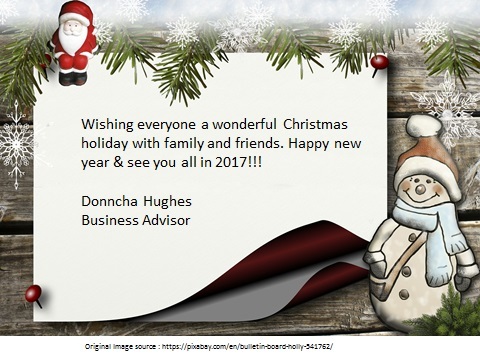
A gift : 2.5 minutes of your time
I love Lackagh Choir’s When a Child is Born available to listen free on Soundcloud. Pure Brilliant – well done to all involved. Their first CD was superb so presume that another one is on the way!

Lackagh Choir
Related PostsAll about Startup Digest Galway (Jan 24, 2014)
Startup Digest Galway is new - it aims to feature all startup related events taking place in ...
Seasons Greetings (Dec 20, 2013)
Wishing everyone that I know in business and from other walks of life a brilliant Christmas holiday ...
Lean Startup : Recommended Books to get up to speed (Dec 12, 2013)
I am a big advocate of Lean Startup. This post selects my four favourite Lean Startup books from ...
GMIT’s IiBC to host Livestream of Lean Startup Conference (Nov 29, 2013)
I am really looking forward to Monday 9th December when GMIT's Innovation in Business Centres ...
Setting up my new HP (Windows 8) Laptop (Nov 1, 2013)
Information Technology is very important for small business. A new laptop for a small or home ...
The post Happy Christmas & A little free Gift appeared first on Donncha Hughes, Business Trainer, Advisor & Mentor.
Thanks for signing up to my feed
regards
donncha
p.s why not also check out my other website www.startupwebtraining.com
December 6, 2016
Dealing with difficult clients as a Freelance Consultant
I was asked recently as part of a Q&A to discuss how I deal with ‘difficult clients’ or customers. Having provided a short and off the top of the head response, this post is my reflections on this very interesting question:
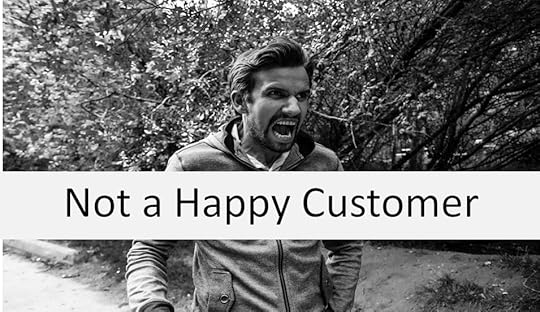
Starting Point : Choose your Customers Wisely
As a freelancer, you get to choose whom you work with. As such if a customer is being ‘difficult’ or ‘troublesome’ the ultimate response is not to work with them. This is relatively easy to do before you start working with the customer. When you meet them, prior to issuing a proposal, you have to make a judgement on whether you can work with them. Is there a fit in terms of personality, working style and values? If not, one has a few options. You can just explain your view of the situation. You can also say that you don’t have time to work with a particular client due to other commitments. Another option is to quote an above market price – at which point the potential customer will probably walk away. You could also refer such clients to other providers who may be more cost effective.
At this pre-contract stage, I will make a judgement on how likely ‘success’ can be achieved for the client. I like to work with clients where there is at least a 90% chance that value can be delivered. This is essentially a judgement call on the core strength of their project or business. If their business has real merit, it a lot easier for me to achieve the desire result and ultimately get paid for my work.
But you need Customers
Freelancer consultants can not fire every customer or you will not have a business. So point one is a last resort tactic. A more sustainable approach is needed:
I think we need to go back to define what a ‘difficult’ or challenging customer is. There are many variations. The following are my two types:
1 – A Customer who does not pay on time.
Equally difficult are clients who do not provide a PO on time. Your invoice is delayed. As a consequence your payment is later than it should be.
2 – A Customer who does not engage fully.
Clients who think that they are right all the time in spite of evidence to the contrary. If they are unwilling to take other views and feedback on board, I consider this to be the most damaging because it is the core value provided. It is a sign that they don’t value your contribution. As such you are wasting your time and theirs. Ultimately, one runs the risk of not getting paid – I seem to keep coming back to that one!
Please feel free at this stage to take some time to create your own list of Difficult customer situations. My list is quiet mild – and doesn’t refer to the potential for customers to behave unreasonably such as acting in a rude and ignorant fashion or worse people who become aggressive and abusive.
Dealing with ‘Troublesome’ Customers:
My general outlook is that people are good by nature. I think that as such there is no such thing as ‘troublesome customers’ rather people who are facing a difficult situation and don’t really know how to react. It is my job to figure out how to make sure that the customer is better off AFTER * dealing with me.
* Andy Bounds’ book The Jelly Effect is one of my all time favourite books
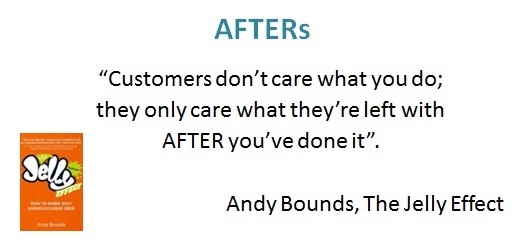
► Step 1 : Understand the challenge and frustration
If the client did not have an issue or a frustration you would not be there. As such it is your job to provide a solution. The task is to alleviate both the technical or functional issue and the emotional frustration. For instance, I have worked with many clients to assist them to develop financial projections. I have developed a financial projections workshop for startups and SMEs. It is a most challenging area for most startup promoters as many will lack an accountancy or finance background. There can be a genuine reluctance and fear to engage with creating financial projections. But entrepreneurs can learn so much about their business from going through the process of creating financial projections (it is a key step in feasibility studies). With the right approach, I find that most entrepreneurs can be convinced to roll up the sleeves to create financial projections when this work is for their own business – as per graphic below!
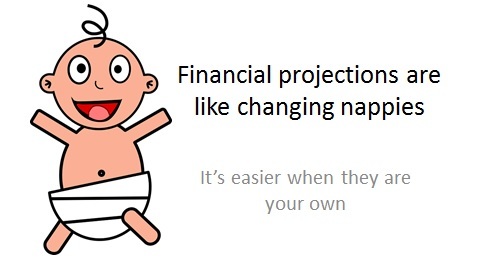
As the expert in an area, the freelancer’s role is both as a teacher and a business advisor. As a trainer one needs a solid training methodology to facilitate the client to learn. One also needs patience. It is very important to acknowledge their real concerns at the outset, and work at a pace that suits the client. I find that such an approach builds trust and confidence.
A key issue at this juncture, is to decide if you can indeed provide a solution. If not, it is time to refer the potential client to someone who can.
► Step 2 : Jointly Assess the Situation/ Take their Side
Most startup entrepreneurs work alone, as in they take the big decisions on their own. When someone takes their side, and adopts an approach of ‘jointly assessing the situation’, this is greatly appreciated. This is equally true in a situation where one is meeting two or even three co-founders. I see this in my own clients. I also see it with participants on programmes such as New Frontiers and StartLab – the Managers act in the best interest of the participants and develop a great bond of trust and respect.
My experience in providing feedback on behalf of Enterprise Ireland to CSF applicants is relevant here. The scenario is that startups have applied on a competitive basis for €50,000 for 10% equity in their company. They have been informed that on this occasion they have been unsuccessful in getting to the 2nd stage which involves a pitch. The applicants are given a time when they will be given feedback on their application in a 15 minute call. We generally make up to ten calls in succession in a half day. I find that the calls are in general hugely positive. During the evaluation stage, time is taken to provide feedback on the scores given across the set criteria – these are published on the EI website. During the call I will read out the feedback. I will also ask two questions. I generally ask what the applicant thinks of the feedback; and has anything changed that would change the feedback the next time. Most people agree with the feedback and most have made progress in their startup journey. This makes for a positive experience. On other calls, the conclusion is that the nature of the business means it is not a suitable fit for CSF – it is a competitive process. When applicants are able to draw this conclusion for themselves, this can provide a type of closure that applicants appreciate. It means that they can set an appropriate path for the business. I make a point at the outset of explaining that I don’t work for EI but for CSF I work with them. I am trying to set the tone that on the call, ‘we’ are trying to jointly assess the situation.
By happy coincidence, as I was finalising this post, I read chapter 55 of Andy Bounds’ The Snowball Effect on the topic of ‘challenging conversations’.
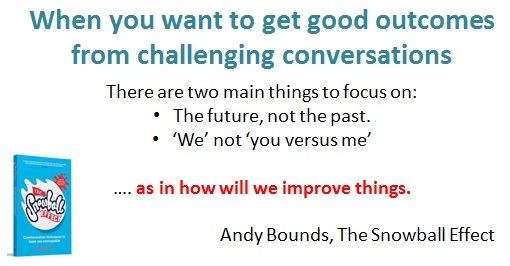
► Step 3 : Assist them to take Control
The follow on step is to help the client to devise a solution or create a plan to tackle the issue. It is critical that the person is fully involved in the creation of the plan and fully understands the principles underlying the plan. A plan which is imposed or simply given to a client has less chance of being implemented.
This step could be titled ‘Give Control back to the Client’ because that is what I try to do. The likelihood is that some customers are not in control of their emotions or their business when you meet them first. I find that I take ‘control’ of our process of engagement in those situations.
When one thinks of difficult customers, one will probably think of emotional outbursts and unreasonable behaviour. Extreme misbehavior can not be tolerated, but sometimes a customer needs space to vent (or even to cry). Most people agree that emotions should not be repressed. And as I mentioned above, most startups founders/ co-founders work alone. So it is extremely useful to have someone who they can be totally honest with. Ground rules can then be established- emotions must be constructive.
The second area where startups may not be in control is their business. The startup world is full of contradiction and confusion. It is very easy to get caught up in the detail of the business and not see the big picture. It is equally easy to get overwhelmed by the big picture and be paralyzed into a state of inaction. This affects even experienced business people never mind people emerging from engineering or software development with limited business expertise and acumen.
This is why I am such an Advocate of Lean Startup. This is the principle that assumptions should be created, and then tested in the market, before changes can be made to the business. This thinking can be applied to all elements of the business not just product development.
When advice or guidance is not taken on board, it is important to not take it personally. Ask them to consider the evidence ie to undertake some market tests and to base their decisions on the evidence. After all it is not the job of advisors to make decisions but to assist the entrepreneur to devise a plan. A critical step in devising such a plan is to consider all the options. This ideally should involve learning from the experience of other businesses – which I can share with startups during our discussions.
By following this approach, I am hoping to transfer a process for decision making to the client. This is handing them back control. I think that this is a process of developing self awareness.
Build trust, be honest and engage in open communication. Provide value! Then you can ask to be paid. You should also have a relationship that allows you to chase your customers for payment – going back to the earlier point that people are intrinsically good, they are not delaying payment to cause undue harm but they are under pressure themselves.
Conclusion
It is often said that the Customer is always right. I don’t necessarily agree with this – it is not a universal truth. I would add that oftentimes there is no right or wrong, just an opportunity to put things right. As such it is important that the customer is placed at the centre of the solution and that every effort is made to deliver a package that solves their issue, in its many dimensions.
As always, I hope you enjoyed this post. Comments and shares on social media welcome.
regards
donnncha
[My latest blogpost] addresses my thoughts on 'Dealing with difficult clients as a Freelance Consultant' https://t.co/QDX4MGummt #marketing
— Donncha Hughes (@donnchadhh) December 6, 2016
Image Credits
https://pixabay.com/en/man-male-angry...
https://pixabay.com/en/baby-cheer-che...
http://ttte.wikia.com/wiki/Troublesom...
Related PostsWhat ‘grants’ and other supports apply to my startup business? (Jan 10, 2015)
If you have ever wondered what supports that you and your startup business could and should apply ...
SCCUL Mentoring Programme Autumn Business Seminar (Sep 5, 2014)
I was delighted to be asked by Liam Bluett and Michael Smyth of Ballybane Enterprise Centre to ...
Running a small self employed service business (Jan 28, 2014)
A self employed person running a professional services business has a different outlook to most ...
How to build a business from your skills, domain knowledge and life experience? (Oct 7, 2013)
I recently wrote a blogpost for Tweak Your Biz discussing my answer to ‘What do you think of my ...
Friday evening question to ponder – how do you run up a hill? (May 3, 2013)
I asked myself a question today - How do you run up a hill? What is the best way? This raised more ...
The post Dealing with difficult clients as a Freelance Consultant appeared first on Donncha Hughes, Business Trainer, Advisor & Mentor.
Thanks for signing up to my feed
regards
donncha
p.s why not also check out my other website www.startupwebtraining.com
August 10, 2016
Role of SEO in marketing your freelance business
Have you ever wondered does SEO, inbound marketing and a blog work for a small business? How important is SEO and content marketing within the marketing mix of a freelancer. I think that the answer is that it has been beneficial for my self employed consultancy and training business based in the West of Ireland. This blogpost will review my experience as a freelancer for over 6 years in order to present the marketing formula for my business.
Marketing as a Freelancer is about securing Revenue at minimal Cost
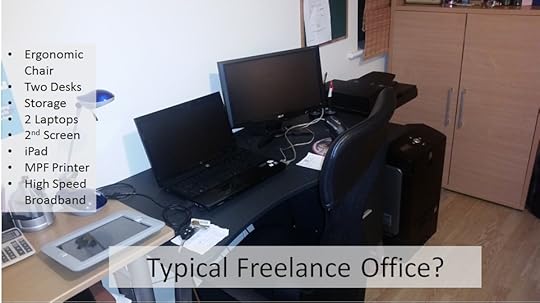
The image above may provide some context for my business. As a self employed freelancer operating from my home office, I have limited overhead. The vast majority of fees invoiced to clients is for my salary (after tax). I offer a very niche range of services. I aim to provide a professional and personal service to the startups, small business owners and enterprise agencies that I work with.
Starting Point : Effort expended on SEO and Content Marketing
I am fully responsible for my own websites. SEO is also my responsibility. I have read a few eBooks and blogs on SEO (Moz and Backlinko are top of my list). I try to follow best practice in terms of WordPress SEO. My business naturally generates ideas for blogposts:
► This will be my 70th blogpost (along with 28 pages) on this website. Six of the posts are from 2016.
► I have written 7 LinkedIn Pulse articles.
► I have 13 articles published on network blogs – these are great for increasing social media profile.
► There are downloadable pdf resources on my website.
► I have also created 12 Slideshare presentations and some YouTube videos.
So I am steadily over time creating a library of content that should be relevant to my target audience. This is part of developing an effective inbound marketing strategy.
Next Issue: How to evaluate if your SEO effort is providing a return?
A key question of any marketing activity is whether it is worth the energy and money devoted to it. Does it provide a return?
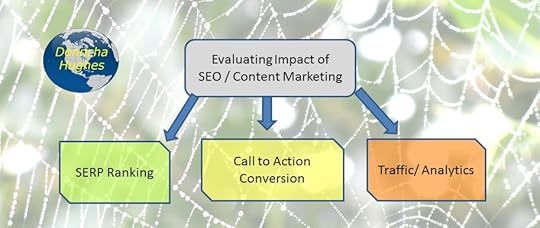
The return that I am looking for is:
a- to enhance my reputation as an expert in niche business areas; and
b- to provide information to potential clients and to encourage them to contact me.
This is somewhat intangible but I will try to quantify. We will look firstly at website traffic using Google Analytics. This can be complemented by reviewing level of inquiries for services via my website.
Please note that I do not offer Search Engine Optimisation consultancy.
I do provide group training to startups and small business entrepreneurs on SEO. The one day training workshop (1st September 2016 – Galway) aims to provide an understanding of best practice SEO at the beginner to intermediate level. The objective is to facilitate participant businesses to manage key elements of their SEO internally as part of their Marketing Communications.
Website Analytics: is my content being read by potential customers?
For the record, here is a snapshot of my web traffic.
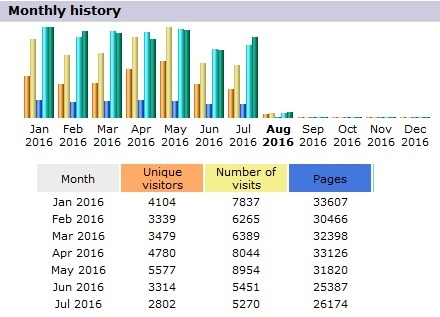
AWS Stats as supplied via Domain Host
Google Analytics records:
– 10,924 Users in seven month period January to end July 2016 with 15,323 pageviews
– 81% via organic search, direct 12%, referral 6%, and social 1%
– 63% desktop; 31% mobile and 6% tablet
– Top 2 landing pages were blog posts with the full domain in 3rd place.
– Slow average site and page loading speed. [Must add to To Do list]
While Google Webmaster tools shows:
– 107 internal links, and
– 309 external links.
– Top search queries and clicks presented in table format.
It is interesting that a post published 2 years ago was my top page in the first seven months of this year recording over 1500 pageviews. A potential client specifically mentioned that post when we met. And it seems that people are spending on average over 8 minutes reading the post. Well worth my time to write it!
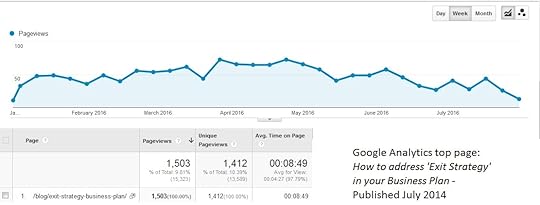
Finally, as an experiment I set up Google Adsense a few months ago. I will shortly be receiving my first payment of €10 to my paypal account. Which is a neat segue to the real issue of money and turnover from client work.
Leads from this Website
Over the last year, I have noticed an increase in genuine enquiries from my website:
1- Two requests for assistance with Feasibility studies; one from Listowel and the other from Cork City.
2- A request from the UK for assistance with Market Research on the Irish market.
3- Two requests to write Business Plans; one from Dublin, and one from Galway.
4- Two requests to review Business Plans.
5- One request to develop financial projections for submission of a bank loan application.
6- Four requests for assistance with responding to Tender requests.
7- Two inquiries about providing Training, one as a partner.
8- One general request for mentoring on enterprise agency financial supports for a business (in Ennis).
9- One general request for support with growing a business (in Dundalk).
10- Two requests for information about applying for Short Term Enterprise Allowance and business plan for same (from Dublin and Athlone).
From recollection that is at least 18 genuine emails in the last six or so months. Please note that I do not strictly track emails from my website. After responding, I put them all into one folder in my email client.
Not all of these turn into business. I would consider them to be early stage unqualified leads. But some have – I recently invoiced 2 of the above (which prompted this post). I ask everyone who rings where they got my name. Increasingly the answer is that they found me online. As such these are all from people that I did not know or who did not know me. They also had not been referred by a mutual contact. For me it proves that SEO and more broadly inbound marketing works.
Conclusion: How I win business?
This post got me thinking about how I win business – what is my marketing approach. I don’t spend money on marketing per se but there is significant time and some minor expense incurred within the communications cost category.
Going back to my original question – how important is SEO and my website. To answer the question, I formulated my Freelance Marketing Formula as presented below:
The formula is from my own experiences. I do not know if it applies to other freelancers but I think that it might. So the model is based on qualitative experience rather than quantitative data. I hope it is fairly self explanatory. You may notice that advertising is not included. This is because I have never advertised either online or offline. I was very lucky when I started to be asked by some customers to do some work and the business evolved particularly via tenders and sales proposals from direct sales.

The major element of the formula is winning repeat business which results from excellent service delivery. I deliver some services for clients on an annual basis e.g. training programmes. Repeat business also includes follow up consultancy and mentoring. [In 2015, I had 19 customers of which 9 were repeat. These 9 accounted for 72% of income].
Positive Word of Mouth leading to referrals is primary source of new clients closely matched by Tenders.
I would always have considered SEO/ Content Marketing and Social Media as a factor in generating brand awareness. I would also consider it useful in confirming good impressions created via tender documents and referrals. It is welcome to realise that the website is also a lead generator in its own right.
As always I hope you enjoyed this post. Comments welcome while RTs and shares on social media are greatly appreciated.
regards
donncha
[latest blog] Role of SEO in marketing your freelance business https://t.co/tEXXzqT1jC #seo #WordPress #Marketing #Freelance
— Donncha Hughes (@donnchadhh) August 10, 2016
Go to top
Related PostsHow to make your business plan or tender document look professional? (Feb 6, 2014)
I write several business plans for clients every year and I also regularly create tender documents ...
How to write your Press Release? (Jun 17, 2011)
Public Relations (PR) is coverage of your business in the media - tv, radio, newspapers, magazines ...
Six key tips for tendering (Apr 30, 2011)
I was talking last week about what makes a good tender and how a start up company should approach ...
How to listen to your customers to get them to buy? (Mar 24, 2011)
When you meet a potential customer are you confident that you can figure out how to help them to ...
Sources of Secondary Market Research (Mar 10, 2011)
Last night was workshop 2 of the six week Start Your Own Business Programme delivered on behalf of ...
The post Role of SEO in marketing your freelance business appeared first on Donncha Hughes, Business Trainer, Advisor & Mentor.
Thanks for signing up to my feed
regards
donncha
p.s why not also check out my other website www.startupwebtraining.com
April 11, 2016
Good strategy; the importance of proximate goals
Goal setting is a key component of strategy development but it is not Strategy. In many cases, the key question ‘How are we going to do that’ is not answered. Strategy is not what you hope your performance is going to be. Strategy is about how you are going to get there. This is one of the central tenets of a superb book Good Strategy, Bad Strategy: The Difference and Why it Matters, by Richard Rumelt (Profile Books, 2011). This blogpost will outline some thoughts on Good Strategy having read this fantastic book.
What is your Strategy?
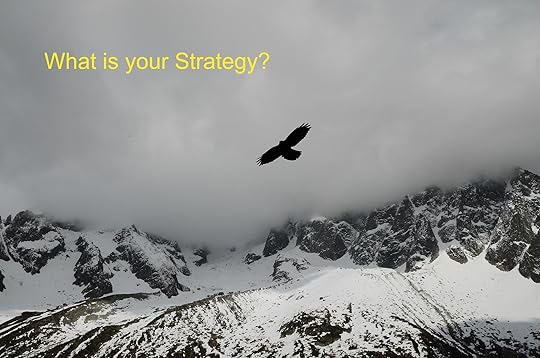
I think that this image of the Eagle in the sky is highly appropriate for a discussion on strategy. If one was to impose the terminology of business strategy within this context, one could say that:
– Purpose (preferable to the word Mission) of the Eagle is to secure food. It is not necessarily to be the best eagle in the world or even in its local area. This is on basis that ‘the customer’ is her family who require food.
– The key resources are Sight, Power and Speed and of course location or territory. I was watching a BBC documentary recently which explained how the design of the wing is ideal for riding thermals. Using awesome skills, the eagle is a brilliant example of efficient use of energy.
So the strategy is clear. This is without spending time on elaborate vision statements. I also don’t think it matters whether this strategy is conscious, evolving or driven by natural instinct but one can definitely associate this image with the art of learning, skill acquisition and risk management.
Amazon’s Strategy
The question is whether a business strategy can be illustrated or stated as simply as the Eagle. Yes according to this fascinating post about Amazon.
The image below comes straight from Amazon – originally it was a napkin sketch by Jeff Bezos. Note that there’s no arrow pointing outwards labelled ‘take profits.’ This is a closed loop.
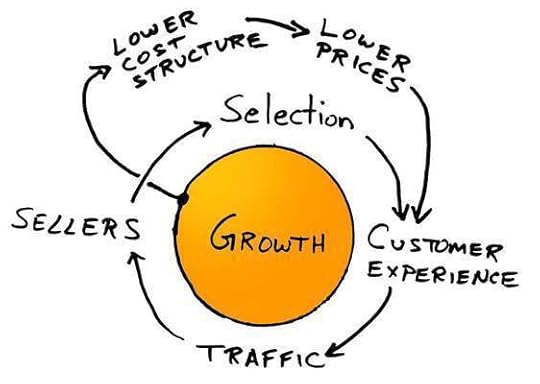
As I was writing this article, I came across a superb article about Intuit and HubSpot. The author makes the point that there are many really large successful software companies that target large enterprise. But there is only one really large business that targets and serves small business. The article explains why and how to overcome the inherent obstacles in such an approach – focuses on the why behind the how!
What is Good Strategy?
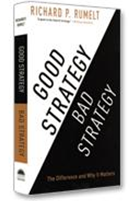 It is somewhat difficult to pick a good business book to read. This is especially so in the area of strategy. I decided to read this particular one having watched this video on YouTube (it is 90 minutes but well worth watching).
It is somewhat difficult to pick a good business book to read. This is especially so in the area of strategy. I decided to read this particular one having watched this video on YouTube (it is 90 minutes but well worth watching).
The book Good Strategy, Bad Strategy: The Difference and Why it Matters, by Richard Rumelt (Profile Books, 2011) is superb. The author is acknowledged as one of the world’s leading thinkers on strategy and management. Shortlisted for the Financial Times and Goldman Sachs Book of the Year 2011 you can read a worthy review on Summary.com and this is a superb opinion piece published by the Washington Times.
Author Richard P. Rumelt emphasizes, goals are not strategy. Goals are wishes. Strategies are how one goes about achieving goals.
Some (six) of my highlights from the books include:
#.1 A good strategy does more than urge us towards a goal or vision.
The core of strategy is discovering the critical factors in a situation and designing a way of coordinating and focusing actions to deal with those factors. The greater the challenge, the more a good strategy focuses and coordinates efforts to achieve a powerful problem solving effect.
#.2 A good strategy has an essential logical structure that Rumelt calls a Kernel.
The kernel of a good strategy contains three elements: a diagnosis, a guiding policy and coherent action.
– A diagnosis defines or explains the nature of the challenge. A good diagnosis simplifies the often overwhelming complexity of reality by identifying certain aspects of the situation as critical.
– The guiding policy specifies the approach to dealing with the obstacles called out in the diagnosis.
– Coherent actions are feasible co-ordinated policies, resource commitments, and actions designed to carry out the guiding policy.
Good guiding policies follow from visions of desirable end states. They define a method of grappling with the situation and ruling out a vast array of possible actions. For example, Wells Fargo’s corporate vision is this: “We want to satisfy all our customers’ financial needs, help them to succeed financially, be the premier provider of financial services in every one of our markets, and be known as one of America’s great companies”. The ‘vision’ communicates an ambition, but alone it is not a strategy because there is no information about how this ambition will be achieved. Wells Fargo Chairman emeritus and former CEO Richard Kovacevich knew this and emphasised a guiding policy based on cross-selling. He believed that the more different financial products Wells Fargo could sell to a customer, the more the company would know about that customer and about its whole network of customers. That information would, in turn, help it create and sell more financial products. This guiding policy, calls out a way of competing – a way of trying to use the company’s large scale to advantage.
#.3 Strategy is the application of strength against the most promising opportunity.
A good strategy doesn’t just draw on existing strength, it creates strength through the coherence of its design. The opposite however is often the reality – organisations pursue multiple objectives that are unconnected with one another, or worse, that conflict with one another.
#.4 Problem diagnosis is the first step in strategy development.
The most powerful strategies arise from game changing insights – of customers, markets, competitors, regulators and industries. A guiding policy creates advantages by anticipating the actions and reactions of others, by exploiting the leverage inherent in concentrating effort on a pivotal or decisive aspect of the situation, and by creating policies and actions that are coherent, each building on the other rather than cancelling one another out.
#.5 Good proximate objectives – one that is close enough at hand to be feasible – are Powerful.
A proximate objective names a target that the organisation can reasonably be expected to hit even overwhelm. In chapter seven, Rumelt explains that President Kennedy’s call for the United States to place a man on the moon by the end of the 1960s is often held out as a bold push into the unknown. Seemingly audacious, however, landing on the moon was a carefully chosen proximate strategic objective. It was a matter of marshaling resources and political will. It was a model in clarity. Good proximate objectives do wonders for organizational energy and focus.
#.6 Dynamic situations require ‘even more’ proximate strategic objectives
Many writers on strategy seem to suggest that the more dynamic the situation, the farther ahead a leader must look. But Rumelt holds that the more dynamic the situation, the poorer your foresight will be. Therefore, the more uncertain and dynamic the situation, the more proximate a strategic objective must be. The logic must be to take a strong position and create options. The question to ask is: what one single feasible objective, when accomplished, would make the biggest difference?
What is proximate for one nation, one organisation, or even one person may be far out of reach to another. The obvious reason is difference in skills and accumulated resources. Which brings us back to the first point in this list, namely that coordinating and focusing action is hugely critical in strategy. The skill of co-ordination should not be under estimated. This requires good people, processes and systems.
To conclude
I am reminded that the concept of setting proximate goals is not new and is indeed a long understood (but maybe forgotten or often ignored) principle. It is as explained on Wikipedia the kernel of the fable ‘Belling the Cat’ .
The fable concerns a group of mice who debate plans to nullify the threat of a marauding cat. One of them proposes placing a bell around its neck, so that they are warned of its approach. The plan is applauded by the others, until one mouse asks who will volunteer to place the bell on the cat. All of them make excuses. The story is used to teach the wisdom of evaluating a plan not only on how desirable the outcome would be, but also on how it can be executed. It provides a moral lesson about the fundamental difference between ideas and their feasibility, and how this affects the value of a given plan.
As I writing this post, Seth Godin’s daily email arrived. The topic ‘What are you competing on?’ … the real power is to ask the right question.
As always, I hope you enjoyed this admittedly long post. All my work with clients involves Strategy in its many guises. If you have a strategy question facing your business, feel free to get in touch. And comments are always welcome, published and responded to.
regards
donncha (@donnchadhh)
The Kernel of Good Strategy is more HOW than HOPE aka Rumelt
Click To Tweet
Related PostsHow to facilitate a group meeting to achieve your goals? (Apr 1, 2011)
This week I was delighted to be asked by Atlantic Way to facilitate a meeting of a group of Artisan ...
The post Good strategy; the importance of proximate goals appeared first on Donncha Hughes, Business Trainer, Advisor & Mentor.
Thanks for signing up to my feed
regards
donncha
p.s why not also check out my other website www.startupwebtraining.com
March 23, 2016
A quick explanation and example of Cashflow (video)
I am not an accountant but I do my own accounts. I also work with clients on financial projections. Finance is at the core of business and marketing. Cashflow is the core of finances. This is a short blogpost to explain Cashflow to business novices using a somewhat realistic scenario. The details are outlined in text and the answer – I should say my thoughts – are in the video.
Cashflow Scenario
The following details are entirely fictitious and any resemblance to any trading business is entirely unintended:
1. Jelly Jumble Ltd owned by Myles Calisto is a pop up sweet shop.
2. Stock is €1 per unit if 1000 units are purchased in a transaction.
3. Myles knows that he will generally sell 250 units per month.
4. He receives a very attractive offer from his supplier:
If he buys 5000 units in the next order, the business can avail of a reduced price of €0.8 per unit. This is a 20% discount.
5. Each unit sells for €2.
6. The other piece of information is that customers either pay Cash (50% of revenue) or pay on invoice within a month (remaining 50% of turnover).
The question is whether Myles should take up this offer? In the video below, I present some introductory financial analysis to assist with making this decision.
While this scenario may seem simplistic, I hope you find this video of use. When creating financial projections for client businesses experiencing Growth, I use a sophisticated Excel based template. However, the concepts presented in the video and the approach remain relevant. I look forward to your comments!
regards
donncha (@donnchadhh)
p.s the video towards the end references the issue of getting paid on time as a challenge for small business. For further reading on ‘good cash flow management’, I recommend SAGE’s free 9 page pdf ‘Advice to manage your finances and cash flow‘ which can be downloaded from their site. Please note that I have no business relationship with SAGE and this is not an endorsement of their service!
Related PostsFinance for Startups : Part I (Mar 4, 2014)
I believe that knowledge of finance to include: an ability to understand and communicate your ...
Service Moments during our recent holiday (Aug 13, 2013)
This is my first post since returning to work after a family holiday. It is not a post about my ...
Happy Christmas from Donncha Hughes (Dec 20, 2012)
I would like to take this opportunity to wish a very Happy Christmas to all the people who I met ...
Diesel versus Petrol my motor cost comparison (Oct 5, 2012)
I changed from a petrol to a diesel car this year. I always wondered how much money this would save ...
What is Dropbox and why I recommend it? (Jan 30, 2012)
I use Dropbox every single day. Dropbox is described as a free* service that lets you bring your ...
The post A quick explanation and example of Cashflow (video) appeared first on Donncha Hughes, Business Trainer, Advisor & Mentor.
Thanks for signing up to my feed
regards
donncha
p.s why not also check out my other website www.startupwebtraining.com
Blog of Donncha Hughes
- Donncha Hughes's profile
- 4 followers


